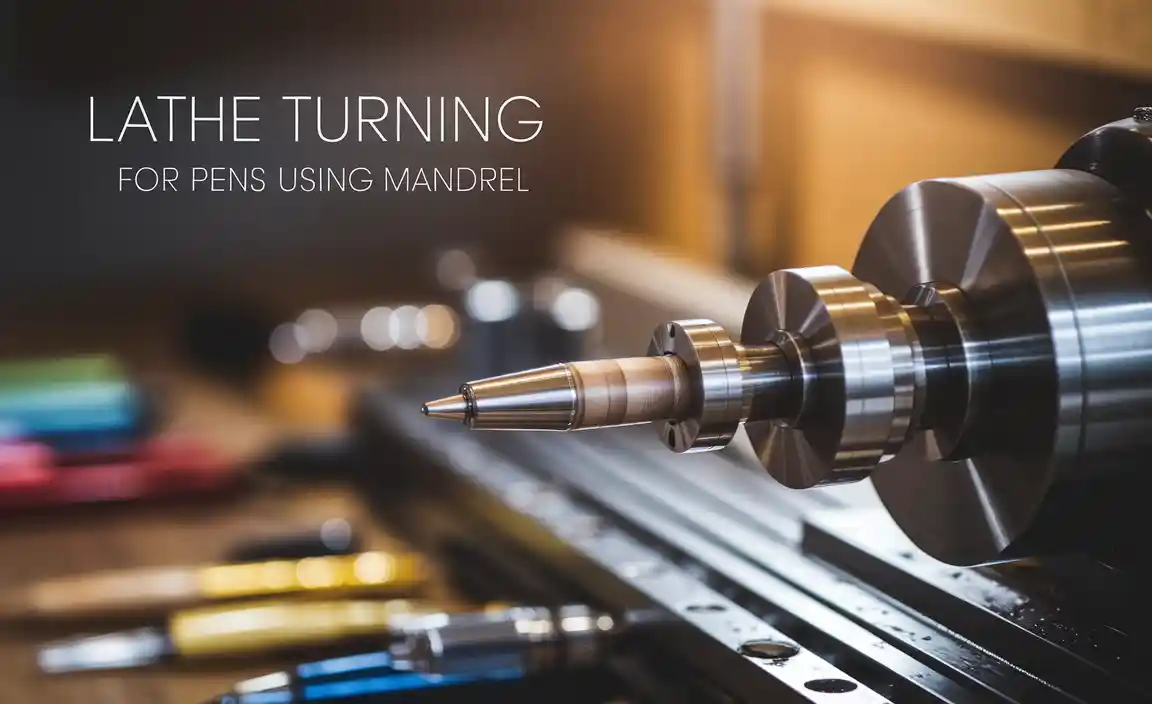The TIAlN ball nose end mill with a 55-degree helix angle is an excellent choice for roughing operations, providing durability and efficient material removal in various materials. It’s ideal for creating complex 3D shapes thanks to its rounded tip.
Welcome to Lathe Hub! If you’ve been looking to tackle more complex shapes on your milling machine, or perhaps you’re just getting started and feel a little overwhelmed by all the different cutting tools out there, you’re in the right place. Today, we’re diving into a tool that might seem a bit specialized but is incredibly useful: the TIAlN Ball Nose End Mill with a 55-degree helix angle. Don’t let the name intimidate you! We’ll break down exactly what this tool is, why you might need it, and how to use it effectively for roughing. Get ready to gain confidence and expand your machining skills.
Understanding the TIAlN Ball Nose End Mill: 55 Degree Edition
Let’s start by breaking down what makes this tool special. You’ve probably seen end mills before, but the “ball nose” and “55-degree helix” parts are key. And that “TIAlN” coating? It’s a game-changer for performance.
What is a Ball Nose End Mill?
Think of a standard end mill – it usually has flat or sharp corners at the tip. A ball nose end mill, on the other hand, has a perfectly rounded tip, like the tip of a ball. This rounded shape is fantastic for creating:
- Curved surfaces and contours
- 3D shapes and complex geometries
- Radiused toolpaths (like fillets and channels)
- Mold cavities and artwork
The rounded tip means it can cut in any direction without creating sharp, undesirable corners in your workpiece. This is critical when you’re aiming for smooth, flowing surfaces.
The 55-Degree Helix Angle Explained
The “helix angle” refers to the angle of the flutes (the spiral cutting edges) on the end mill. Most common end mills have a 30-degree or 45-degree helix. A 55-degree helix angle offers a few advantages, especially for roughing:
- Smoother Cutting Action: A higher helix angle generally leads to a more shearing cut. This means less vibration and chatter, resulting in a cleaner surface finish even during aggressive material removal.
- Improved Chip Evacuation: The steeper spiral helps to pull chips away from the cutting zone more effectively. This is super important during roughing, where you’re removing a lot of material quickly. Good chip evacuation prevents chips from re-cutting, which can damage the tool and the workpiece.
- Better Performance in Certain Materials: This angle can be particularly beneficial when machining tougher, gummy materials like aluminum or certain plastics.
What is TIAlN Coating?
TIAlN stands for Titanium Aluminum Nitride. It’s a very hard and durable coating applied to the surface of the end mill. Think of it like a protective shield. Here’s why it’s so good:
- Increased Hardness: Makes the tool resist wear and abrasion much better.
- Higher Heat Resistance: Cutting generates heat. TIAlN can withstand higher temperatures, allowing you to run your machine at faster speeds and feeds without damaging the tool’s cutting edge. The coating acts as a thermal barrier between the cutting edge and the workpiece.
- Reduced Friction: The slicker surface means less material sticks to the tool (less “built-up edge”), leading to cleaner cuts and longer tool life.
- Suitable for Dry Machining: Because of its heat resistance, TIAlN-coated tools can often be used with little or no coolant, which is great for certain materials or settings.
For roughing applications, where tools are pushed hard and generate significant heat, a TIAlN coating is almost essential for good performance and tool longevity.
Why Use a 55-Degree TIAlN Ball Nose End Mill for Roughing?
Now, let’s tie it all together. Roughing is the initial stage of machining where you remove the bulk of the material to bring the workpiece close to its final shape. It’s about efficiency and speed. This specific end mill is designed precisely for tasks like this.
Benefits for Roughing:
- Aggressive Material Removal: The combination of the ball nose shape and the 55-degree helix allows for deep cuts and fast material removal across curved surfaces.
- Durability: The TIAlN coating means it can handle the heat and wear associated with heavy-duty roughing, leading to longer tool life.
- Versatility: It can effectively rough out a wide range of materials, from softer plastics and aluminum to harder steels and composites.
- Reduced Chatter: The smoother cutting action provided by the higher helix angle helps prevent vibration, which is crucial for roughing to avoid damaging the tool or workpiece and to achieve a reasonably good surface finish for the next stage.
This tool is particularly useful with CNC (Computer Numerical Control) machines, where precise toolpaths are programmed. It excels in creating complex 3D forms that are difficult or impossible with standard end mills. For example, when machining molds for plastic injection or creating intricate artistic sculptures in metal, this type of end mill is a go-to tool for the initial material hogging phase.
Key Features to Look For
When you’re choosing a 55-degree TIAlN ball nose end mill, there are a few things to keep an eye on to make sure you get the right tool for the job.
Shank Diameter and Overall Length
These need to match your machine’s collet or tool holder. Standard sizes are common, but always double-check your machine’s specifications. A longer tool might be needed for deeper pockets, but be aware that longer tools can be less rigid and more prone to vibration.
Number of Flutes
For roughing, end mills typically have fewer flutes (2 or 3) than finishing end mills. This is because more space between the flutes allows for better chip evacuation. A 2-flute end mill is often preferred for roughing, especially in softer materials, as it provides maximum chip clearance. A 3-flute can also work well and offers a bit more rigidity.
Material of the End Mill
Most high-quality end mills, especially those with coatings like TIAlN, are made from Solid Carbide. Carbide is extremely hard and brittle, making it perfect for high-speed cutting and maintaining sharp edges. Make sure your tool is solid carbide if you plan on aggressive machining.
Ball Radius
This is the size of the radius at the very tip of the end mill. It determines the smallest internal radius you can create in a corner. Common radii range from 0.5mm for fine detail to much larger sizes for substantial contouring. For roughing, you’ll often see medium to larger radii.
Here’s a quick look at common specifications:
| Feature | Typical For Roughing | Why It Matters |
|---|---|---|
| Helix Angle | 55 Degrees | Promotes smoother cutting, better chip evacuation, and reduced chatter. |
| Coating | TIAlN (Titanium Aluminum Nitride) | Enhances hardness, heat resistance, and reduces friction for aggressive machining. |
| Flute Count | 2 or 3 Flutes | Allows for efficient removal of large amounts of material (chips). |
| End Type | Ball Nose | Essential for creating contoured, 3D surfaces without sharp corners. |
| Material | Solid Carbide | Provides the hardness and rigidity needed for efficient metal removal. |
Setting Up for Success: Safe Practices and Machine Settings
Before you even think about cutting, safety and proper setup are paramount. Machining involves powerful tools and high speeds, so a little caution goes a long way. Always wear appropriate safety gear!
Safety First!
- Eye Protection: Always wear safety glasses or a face shield. Flying chips are a serious hazard.
- Hearing Protection: Milling can be loud. Wear earplugs or earmuffs.
- Proper Clothing: Avoid loose clothing, jewelry, or anything that could get caught in the machine.
- Secure Workpiece: Ensure your workpiece is firmly clamped in a vise or held securely by other means. A loose workpiece can become a dangerous projectile.
- Guards: Keep machine guards in place and functional.
For more in-depth safety guidelines, you can refer to resources like OSHA’s “Metalworking Machine Safety” page, which provides comprehensive information on safe operating procedures for various machinery.
Machine Settings for Roughing
Setting the correct speed and feed rate is crucial for efficient and safe roughing. This is where things can get a bit technical, but we’ll keep it simple.
Spindle Speed (RPM)
This is how fast the spindle (where the end mill is held) spins. It’s measured in Revolutions Per Minute (RPM).
A good starting point for a 1/2 inch (12mm) solid carbide 55-degree TIAlN ball nose end mill in aluminum might be around:
- For Roughing: 3,000 – 8,000 RPM
For harder materials like steel, you’ll typically need to reduce the RPM. Always consult the tool manufacturer’s recommendations if available.
Feed Rate
This is how fast the tool moves through the material. It’s usually measured in inches per minute (IPM) or millimeters per minute (mm/min).
For roughing, you want a feed rate that allows the tool to remove material effectively without bogging down the spindle. A common strategy is to set the feed rate based on the “chip load” – the thickness of the material removed by each cutting edge per revolution.
A general guideline for chip load for a 1/2 inch (12mm) solid carbide end mill in aluminum might be:
- For Roughing: 0.003 – 0.006 inches per tooth (or 0.08 – 0.15 mm per tooth)
To calculate feed rate: Feed Rate = (RPM Number of Flutes Chip Load)
Example: For a 1/2″ end mill, 4000 RPM, 2 flutes, and a chip load of 0.005″:
Feed Rate = 4000 RPM 2 flutes 0.005 in/tooth = 40 IPM
Depth of Cut (DOC)
This is how deep the end mill cuts into the material on each pass.
For roughing, you can take fairly aggressive depths of cut.
- For Roughing: 0.5 to 1.0 times the diameter of the end mill. So, for a 1/2 inch end mill, you could try a depth of cut of 0.25 to 0.5 inches (6mm to 12mm).
Always start conservatively and increase the DOC if the machine and tool can handle it without excessive chatter or load.
Fixturing and Workholding
Your workpiece needs to be held very securely. A vise is common for smaller jobs. For larger parts, you might use clamps or specialized fixtures. Ensure the clamping mechanism doesn’t interfere with the toolpath.
Coolant/Lubrication
While TIAlN is good for heat resistance, using a cutting fluid or coolant is still highly recommended for most metalworking. It:
- Cools the cutting edge, extending tool life.
- Lubricates, reducing friction and improving surface finish.
- Helps wash away chips.
Flood coolant systems are common, but for smaller workshops, a mist or spray coolant system can be very effective. For some plastics and aluminum, you might get away with air blast or even dry machining, but always consider the material and your specific setup.
Step-by-Step: Using Your TIAlN Ball Nose End Mill for Roughing
Let’s get down to the practical steps. We’ll assume you’re working with a CNC mill, as this tool is most commonly used in that environment for 3D contouring, but many principles apply to manual milling as well.
Step 1: Prepare Your Workpiece and Machine
- Ensure your workpiece is clean and securely clamped in your vise or fixture.
- Install the 55-degree TIAlN ball nose end mill into the machine’s spindle using the appropriate collet and tool holder. Make sure it’s seated properly.
- Set up your coolant system if you are using one.
Step 2: Set Tool Length Offset (CNC)
This is crucial for any CNC operation. You need to tell the machine exactly how long your tool is from the face of the spindle to the tip of the end mill. This is often done using a tool length setter or by manually jogging the tool down to touch off on a known surface.
Step 3: Define Your Material Stock and Zero Point
In your CAM software (Computer-Aided Manufacturing) or directly on the CNC controller, you’ll define the boundaries of your raw material (stock) and set your machine’s zero point (X, Y, Z origin) on the workpiece.
Step 4: Program Your Toolpath for Roughing
This is typically done using CAM software. You’ll:
- Select the 55-degree TIAlN ball nose end mill as your tool.
- Define the desired material removal strategy. For roughing, common strategies include:
- 2D Adaptive Clearing: Works well for pockets and contours, allowing the tool to take large, efficient steps.
- 3D Adaptive Clearing (or Volumetric Roughing): Excellent for complex 3D shapes, it systematically removes material in layers.
- Parallel Passes: Often used for contouring along a surface.
- Input your cutting parameters (speeds, feeds, depth of cut, stepover – the distance the tool moves sideways between passes). Remember, for roughing, a larger stepover (e.g., 40-70% of the tool diameter) is often used to speed up the process.
- Generate the G-code (the machine instructions).
Step 5: Perform a Dry Run (Optional but Recommended)
Before cutting into your expensive material, run the programmed toolpath with the spindle OFF (a “dry run”). Watch the tool’s movement through the air to ensure it’s not crashing into the workpiece, fixture, or machine elements. This is a vital safety check.
Step 6: Execute the Roughing Operation
- Turn on the spindle and coolant (if used).
- Start the G-code program on your CNC machine.
- MOLTEN METALS AND HIGH-SPEED MACHINERY DON’T STOP FOR ANYTHING. Be alert and monitor the entire process.
- Listen to the machine. Any unusual noises, like excessive chatter or a strained spindle, could indicate a problem with your settings or tool engagement. Be prepared to hit the emergency stop if necessary.
- The machine will now proceed to remove the bulk of the material, leaving enough stock for a finishing pass.
Step 7: Inspect and Prepare for Finishing
Once the roughing cycle is complete:
- Carefully inspect the workpiece for any issues, missed areas, or damage.
- Ensure that the correct amount of material has been left for your finishing toolpath. This “stock to leave” setting is defined in your CAM software and is usually a small value, like 0.010″ (0.25mm) or less.
- Clean chips away from the workpiece and machine.
- You are now ready to use a finishing end mill (often a smaller ball nose or a T-slot cutter for specific features) to achieve the final dimensions and surface finish.
Materials Best Suited for This Tool
The 55-degree TIAlN ball nose end mill is quite versatile. Here are some materials it handles exceptionally well for rough roughing:
- Aluminum Alloys: Machines beautifully, with excellent chip formation and removal.
- Plastics: Such as ABS, Delrin (Acetal), Nylon, and Polycarbonate. The shearing action of the 55-degree helix is great for these materials.
- Mild Steels: Can be roughed effectively, especially with good coolant.
- Brass and Copper Alloys: Machines cleanly.
- Composites: Like carbon fiber or fiberglass reinforced plastics, though specific tool geometry and speeds might be needed for optimal performance and to avoid delamination.
For very hard steels or






